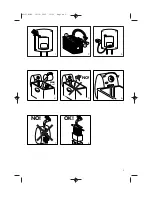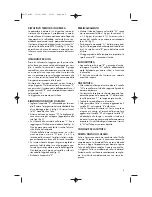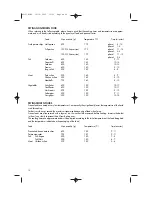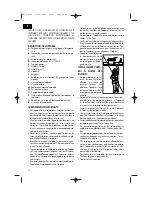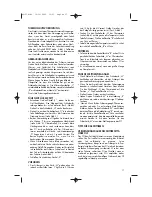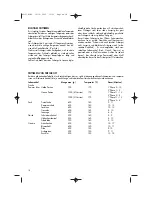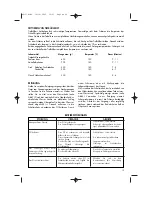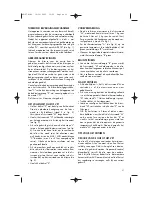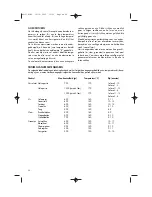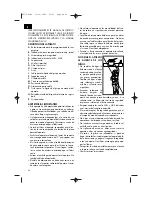
9
OPERATING INSTRUCTIONS
Before using the deep fryer for the first time, carefully
clean, using warm water and dishwashing detergent,
the basket, the bowl and the cover. The control unit,
power cable and heating element may be cleaned using
a damp cloth. Check that water does not enter into the
control unit and that there is no residual water in the bot-
tom of the removable bowl. Carefully dry all the parts.
Check that the control unit is properly fastened to the
deep fryer body. The safety micro-switch “C” will not
allow the appliance to be operated if the control unit “R”
is not correctly positioned in the casing “H”.
The deep fryer is now ready for use.
FILLING WITH OIL OR FAT
• Remove the cover “K”, lifting it by the handle. Turn the
folding handle of the basket until it locks into place
(pos. 2, Fig. 2). Remove the basket “M” by lifting it
upwards.
• Remove the length of cable required to connect the
appliance to the mains, from the cable compartment
“O” (see Fig. 3).
• If oil is used, pour it into the bowl “L” until reaching
the maximum level indicated (see Fig. 4). Never
exceed this limit, as oil may overflow from the contai-
ner. The level of oil must always be between the maxi-
mum and minimum limits, “D” (3 or 4 litres max.
depending on version). For best results, use good
quality peanut oil.
• If lumps of fat are used, cut the lumps into pieces and
melt them in another container, then pour the lique-
fied fat into the deep fryer bowl. Never melt the fat in
the basket or on the deep fryer heating element (see
Fig. 5).
• Close the cover “K”.
PREHEATING
• Place the food to be fried in the basket “M”, without
overfilling (1 kg max. for the 3 litre version and 1.3
kg for the 4 litre version). Check that the handle of the
basket is correctly positioned (pos. 2 in Fig. 2).
• Move the thermostat knob “A” (see Fig. 6) to the
required temperature (see cooking table). The indica-
tor light "B" changes from green to red.
• When the set temperature is reached, the indicator
light "B" becomes green.
STARTING FRYING
• As soon as the indicator light "B" is green, lower the
basket "M" into the oil very slowly to avoid the hot oil
splashing or overflowing.
• A significant amount of steam will be released: this is
completely normal.
END OF FRYING TIME
• When the set cooking time has elapsed, lift the basket
“M” and check that the food has been cooked to the
required colour.
• If the food is completely cooked, turn the appliance
off by moving the thermostat knob “A” to the “•”
position. The indicator light is green.
• Unplug from the mains socket.
• Allow the excess oil to drain by hooking the basket
“M” onto the support “E” on the bowl.
• N.B. If cooking requires two phases or more than one
cooking cycle is to be performed, at the end of the first
phase, hook the basket "M" to the basket support "E"
and wait until the light becomes green, indicating that
the oil is again at the set temperature. Then slowly
place the basket “M” in the oil a second time.
COOKING HINTS
HOW LONG THE OIL OR FAT LASTS
The level of oil or fat must never fall below the minimum.
Every now and then it must be completely changed. The
life of the oil or fat depends on what foods are being
fried. Food coated in breadcrumbs, for example, dirties
the oil more than simple frying. As for any deep fryer,
the oil deteriorates after being heated a number of
times! Therefore, even if used correctly, it should be
completely changed on a regular basis.
CORRECT FRYING
The recommended temperature should be followed for
all recipes. If the temperature is too low, the oil will be
absorbed. If the temperature is too high, a crust will
form immediately and the inside of the food will not be
cooked.
The food being fried must only be immersed in the oil
when the oil has reached the correct temperature, that
is when the light “B” has turned off.
Never overfill the basket, as this may cause a sudden
drop in the temperature of the oil and thus greasier and
less uniform frying.
Check that the food is sliced into thin, even pieces. If the
slices are too thick, the food will not be well cooked insi-
de, despite its appearance, while even slices will be per-
fectly cooked at the same time.
Carefully dry the food before immersing it in the oil or
fat, to avoid oil being sprayed; furthermore, wet food
will be less crisp after cooking (especially potatoes).
Foods with a high water content (fish, meat, vegetables)
should be crumbed before frying, making sure the
excess flour or breadcrumbs are removed before
immersing the food in the oil.
A5-278IDL 10-12-2003 13:51 Pagina 9



